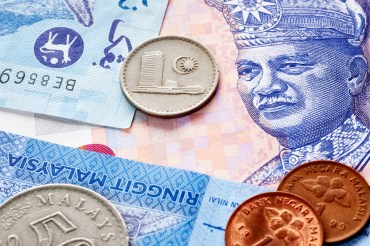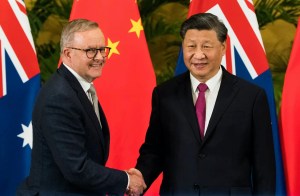Beyond the yen, ringgitâs free fall the one to watch
SINGAPORE – Malaysia’s central bank is under pressure to steady the flagging national currency, the ringgit, which in recent days fell to new multi-decade lows against the US greenback and neighboring Singapore dollar.
Analysts say Bank Negara Malaysia (BNM) now faces a trade-off between raising rates and stifling an already sagging domestic economy or posing risks to financial stability by failing to act. Malaysia’s offshore borrowings, widely denominated in US dollars, amounted to 30 billion ringgit ($6.2 billion) as of August 2023.
Like other emerging market currencies, the ringgit has depreciated this year against a strong US dollar. But the extent of the slide – now the worst performer in Asia after the Japanese yen – has, according to BNM Governor Abdul Rasheed Abdul Ghaffour, belied Malaysia’s otherwise strong economic fundamentals and resilient banking sector.
“We are not in a crisis. It is different from what we experienced in the past,” Abdul Rasheed told reporters earlier this week, referring to the 1997-98 Asian financial crisis when the ringgit hit a benchmark low of 4.88 ringgit to the US dollar in March 1998.
The currency has in recent days tumbled to its lowest levels since, slipping to 4.79 to the US dollar on October 23 and hovering at 4.77 at the time of publication.
The ringgit has dipped by approximately 8.64% to the US dollar so far this year. The currency also breached a record low of 3.48 against the Singapore dollar this week, while also trading lower against most other Asian currencies. Malaysia’s currency traded at 3.48 to the Singapore dollar at the time of publication, depreciating around 6.4% this year.
The BNM governor said recent ringgit fluctuations appear to be driven primarily by geopolitical events, wherein the US dollar has strengthened on safe-haven demand amid concerns about an escalation of the Israel-Hamas conflict into a wider regional war.
“It certainly does not reflect our economic fundamentals,” Abdul Rasheed said, pointing to Malaysia’s current account surplus and moderating inflation.

But seven straight months of decline in exports through September, due in part to weaker-than-expected demand in China, Malaysia’s largest trading partner, has weighed against the ringgit.
The local market, meanwhile, saw net portfolio outflows in the first half of 2023, with global funds reportedly selling off US$324 million of Malaysian stocks in October alone.
“Besides the higher interest rates in the US, which attracted capital outflows from [Southeast Asian] economies as investors seek higher returns…. weaker prices for commodities such as palm oil and liquefied natural gas, which constitute a significant share of Malaysia’s exports, have also affected the country’s export earnings,” said Tan Wen Wei, Asia analyst at the Economist Intelligence Unit (EIU).
BNM paused hiking rates in July, holding its overnight policy rate (OPR) at a record 250 basis point discount relative to the upper bound of the US Federal Reserve funding rate. That widening rate differential has put Malaysia’s central bank on the horns of a policy dilemma given that narrowing the rate gap to stem outflows would require raising rates and hurting the local economy.
Governor Abdul Rasheed told an October 23 press conference that the central bank is committed to taking all necessary measures to maintain a “smooth and controlled adjustment of the ringgit.” He said the BNM possesses “an array of market measures” and is ready to support the sliding ringgit should the need arise, without elaborating on the conditions that could cause the central bank to intervene.
Analysts are of two minds about whether the BNM should raise the OPR to reduce the interest rate differential with the US or pursue other policy options, such as intervening in foreign exchange markets or even imposing capital controls as it did in 1998 at the height of the Asian financial crisis.
“The imposition of such controls [would] risk eroding investors’ confidence and the banking system is better capitalized right now as compared to the past… We do not think BNM will go down this route,” said Tan. “The most palatable option to the BNM will be foreign exchange intervention. This measure has temporary and limited impact, thus it is not sustainable for prolonged periods.”
Deputy Finance Minister Ahmad Maslan said earlier this week that raising the OPR, now at 3%, may no longer be “relevant” given that Malaysia’s headline inflation rate slowed to 1.9% year-on-year in September, marking the first time inflation was below 2% in nearly three years.
He assessed that the US federal funds rate (FFR), now at 5.5%, would likely remain elevated for an extended period as the Federal Reserve seeks to control inflation that, while far lower than a year ago, is proving difficult to tame. Analysts are split about whether the US Fed will raise interest rates at its upcoming October 31 to November 1 meeting.
“Even if the OPR is raised despite easing inflation in the economy, the positive effect on the ringgit will likely be overwhelmed by US rate hike expectations,” said Yeah Kim Leng, a senior fellow and director of the Economic Studies Program at the Jeffrey Cheah Institute on Southeast Asia at Malaysia’s Sunway University.

“Given that currencies under floating exchange rate regimes are prone to misalignments and overshooting, Malaysia’s economy is better off whereby policymakers continue to focus on strengthening the country’s underlying fundamentals. Meanwhile, BNM should continue its policy to smoothen adjustments but not determine the ringgit level or deplete its reserves in its defense.”
Malaysia’s government says 2023 gross domestic product (GDP) growth will come in at the low end of its 4% to 5% forecast after third-quarter growth rose by 3.3%, up from 2.9% in the previous quarter. The World Bank earlier this month revised down its full-year growth forecast for Malaysia to 3.9% from an earlier 4.3%, citing limited fiscal space as a key macroeconomic challenge.
Prime Minister Anwar Ibrahim tabled an expansionary 393.8 billion ringgit ($83.29 billion) budget, the nation’s largest-ever spending plan, on October 13. The plan will gradually cut subsidies on products like petrol, cooking oil and rice that the administration says have disproportionately benefited the rich. The government intends to shift away from blanket subsidies to a system that mainly aids lower-income earners.
“On the domestic front, the recent budget announcement to implement targeted subsidies for diesel and the removal of price caps for chicken and eggs will lead to higher inflationary pressures in the near term, reducing the real returns on investment,” said the EIU’s Tan. “Foreign investors may then seek higher returns elsewhere, and demand for the ringgit is reduced as a result.”
The EIU forecasts that BNM will maintain its OPR at 3% this year. “Tightening the OPR now will weigh further on economic growth, which we think is BNM’s priority now, given that inflation is under control,” said Tan, who added that China’s stronger-than-expected third-quarter GDP figure of 4.9% indicated that its economy may be stabilizing, which in turn could support Malaysia’s fourth quarter trade outlook.
Carmelo Ferlito, an economist and chief executive officer of Kuala Lumpur-based think tank Center for Market Education, argues monetary policy is “an ineffective tool” for firming up the ringgit, which he believes is falling mainly due to external factors. He suggests a consistently pro-market approach to domestic policy would be more effective to stem the currency’s slide.
“The most important factor is the abundance of conflicting messages from the policy perspective. We get commitment to fiscal discipline and yet the biggest budget ever. Price controls were removed only recently despite statements in favor of a pro-investment eco-system,” he said, pointing to pro-market stances amid policy hints of a bigger government role in the economy.
Analysts are mixed on whether the currency could breach the psychological five ringgit to the dollar mark amid prevailing headwinds and uncertainties. Sunway University’s Yeah said the risk of further depreciation cannot be ruled out given the possibility of further interest rate hikes by the US Fed to achieve its 2% inflation target.

“However, slowdown signs and fiscal and financial stresses are emerging in the US economy that suggests a reversal of interest rate uptrend and the dollar strength is imminent in the coming quarters. Malaysia may not see a breach of the psychological five ringgit to a dollar mark if the US economy deteriorates sooner than later,” he told Asia Times.
The EIU’s Tan agreed that a five ringgit per US dollar breach remains unlikely, owing to China’s economy showing signs of stabilization after a lackluster post-pandemic recovery. The research unit maintains its view that the US Fed will not raise interest rates further, assuming US inflation continues to ease and consumer demand softens in September-October.
“A potential slowdown in the US economy may also allow the Federal Reserve to pause and assess if a further rate hike is warranted,” Tan added. “All this is based on the assumption that the Israel-Gaza crisis remains contained. Any escalation into a regional conflict may lead to investors seeking the dollar as a safe-haven, putting further depreciatory pressure on the ringgit.”
Follow Nile Bowie on Twitter at @NileBowie





























